The 9.7" iPad Pro Review
by Brandon Chester on June 1, 2016 9:00 AM ESTSystem Performance
Like the larger iPad Pro, the 9.7" iPad Pro uses Apple's A9X SoC. Apple is never very forthcoming with details like the clock speed for the CPU, GPU, and amount of DRAM. What we can determine about the SoC is that Apple has maintained the 2.2GHz maximum clock speed from the larger iPad Pro, while reducing clocks on the GPU and dropping to 2GB of LPDDR4 RAM.
The RAM situation on the 9.7" iPad Pro is somewhat surprising for a few different reasons. In their always-excellent teardown, the iFixit crew discovered that the smaller iPad Pro only had one Samsung 2GB LPDDR4 memory chip. This explains how Apple scaled down from 4GB to 2GB - the larger iPad Pro had two chips - but it also means that Apple has changed the amount of memory bandwidth available to the A9X SoC as well.
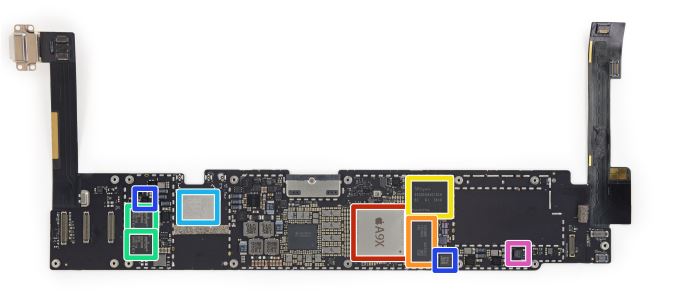
9.7" iPad Pro Logic Board (Image Courtesy iFixit)
To date, all Apple X-series SoCs have shipped with a larger 128-bit memory bus, and until now, Apple always fully populated that bus. So the 9.7" iPad Pro is an outlier in that regard, as this is the first time we've seen an X-series SoC with only the first 64-bit half wired up to a single memory chip in this fashion. In that respect it's a surprising decision from Apple, in part because of the importance of memory bandwidth in feeding the large, powerful GPUs on the X-series SoCs.
Consequently there is going to be more to the 9.7" iPad Pro than just the original Pro in a smaller chassis. The 9.7" iPad Pro should match the larger model in anything that depends heavily on CPU speed or memory bandwidth, while falling behind to some degree in GPU-bound tests. The 12 cluster PowerVR Series7XT GPU inside A9X will be having to make do with less memory bandwidth, though offset to some degree by the lower resolution of the screen.
With the above in mind, I quickly benchmarked the 9.7" iPad Pro on a couple of our memory bandwidth benchmarks. The results are somewhat inconclusive.
| Geekbench 3 Memory Bandwidth Comparison (1 thread) | ||||||
| Stream Copy | Stream Scale | Stream Add | Stream Triad | |||
| 9.7" iPad Pro | 17.1 GB/s | 11.5 GB/s | 12.9 GB/s | 12.8 GB/s | ||
| 12.9" iPad Pro | 20.8 GB/s | 15.0 GB/s | 15.3 GB/s | 15.1 GB/s | ||
I say "inconclusive" because although the 9.7" iPad Pro consistenly scores lower in Geekbench 3's memory bandwidth benchmarks and other memory benchmarks, it's never a 50% drop as we get on paper. In practice these numbers are far from the maximum memory bandwidth A9X is capable of, and I suspect that the CPU paths simply aren't wired in such a fashion that they can fully saturate A9X, especially given the fact that it's the GPU that needs the bandwidth more. So although we see some impact of the narrower memory bus in dedicated memory bandwidth benchmarks, these can't paint a very clear picture. It's going to be our high level GPU performance benchmarks that really give us an idea of the impact of reduced memory bandwidth.
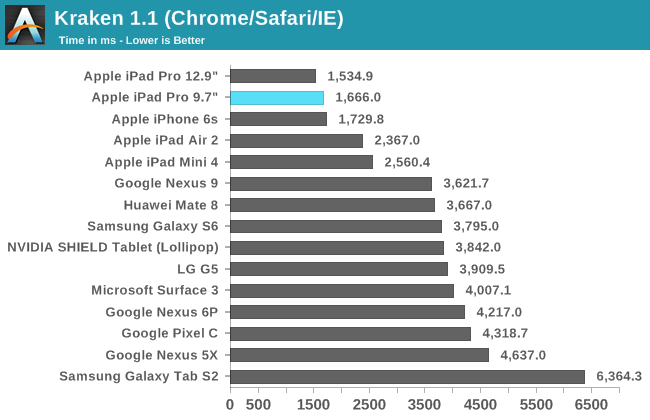
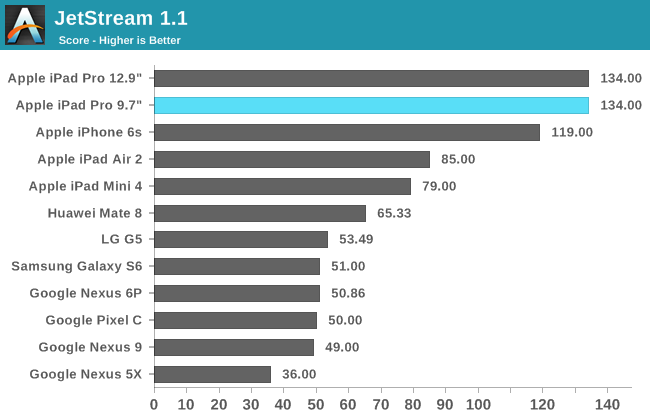
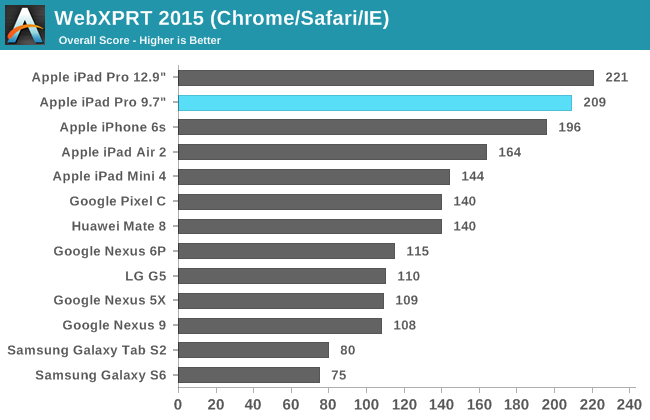
With the 9.7" iPad Pro having the same two 2.2GHz Apple Twister cores as the 12.9" model, it's no surprise to see the two neck and neck in our browser tests. In Jetstream 1.1 the two achieve the exact same score, while in the other two tests the 9.7" model is a bit slower, but with the gap being small enough to attribute to testing variance. With A9X Apple moved back to a dual-core CPU from A8X's tri-core CPU, with the move to TSMC's 16nm FinFET process allowing peak clock speeds to go up by 700MHz. Because JavaScript performance is mostly bound by a device's single threaded performance, A9X came with a significant performance uplift during web browsing. Given that the 12.9" iPad Pro offered the best web browsing performance of a mobile device, bringing that performance to the 9.7" iPad makes for a notable improvement over the performance of the iPad Air 2.
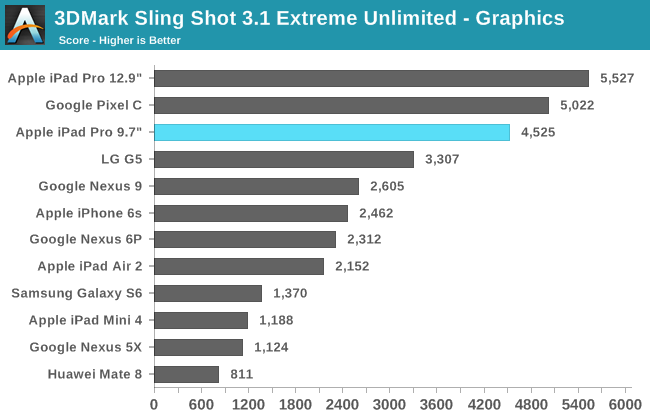
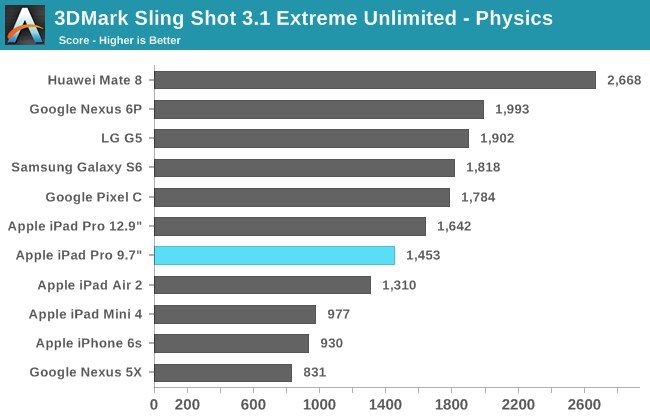

The 9.7" iPad Pro does well in 3DMark's graphics test, but like Ice Storm it doesn't do well in the physics test. It seems that this test is programmed in a similar way to Ice Storm, and in that sense I'm not sure how representative the physics test is of real-world performance because with an actual mobile game you wouldn't use highly random memory access and data structures with heavy memory dependencies when it would perform very poorly on your target devices. In any case, you can see that the 9.7" iPad Pro places third overall, with the 12.9" model at the top of the chart and the Pixel C coming right behind it.
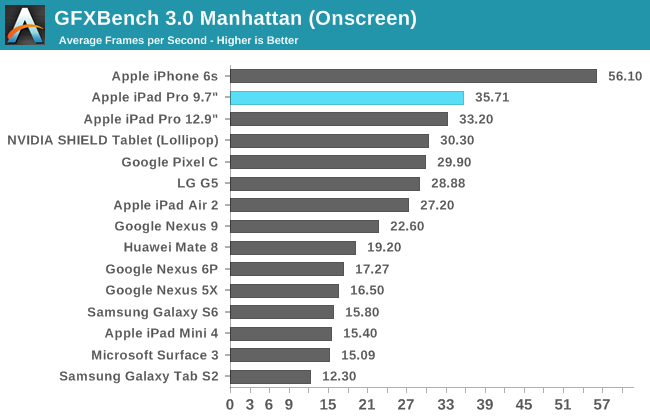
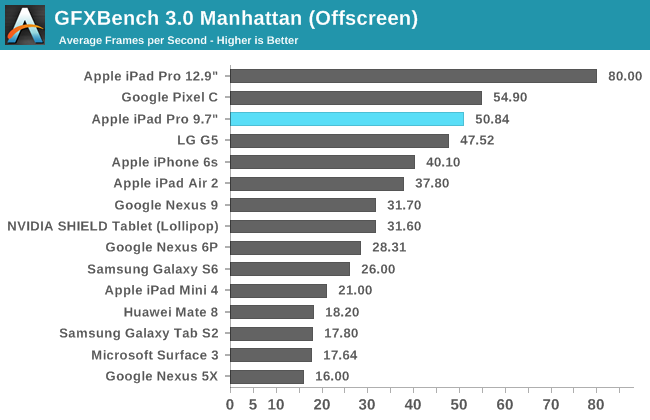
GFXBench 4.0 Car Chase hasn't made its way to iOS yet, and so for now we're still using GFXBench 3.0 Manhattan for iOS devices. Given that the iPhone 6s is the only phone that hits Vsync in this test, it's still a very relevant benchmark in how it represents the level of visual fidelity that a mobile game can currently have on high end devices while still performing well. In the off screen test we can see the impact of the 9.7" iPad Pro's lower clocked GPU combined with the reduced memory bandwidth,, with the smaller iPad performing around 37% lower than that of the 12.9" iPad Pro. The on screen test tells an interesting story though. Both models of the iPad Pro have roughly the same performance at their native resolutions in this test, which could indicate that Apple was targeting the same performance relative to the display resolution when configuring A9X and its memory, in order to manage heat and energy usage in a smaller iPad Pro.
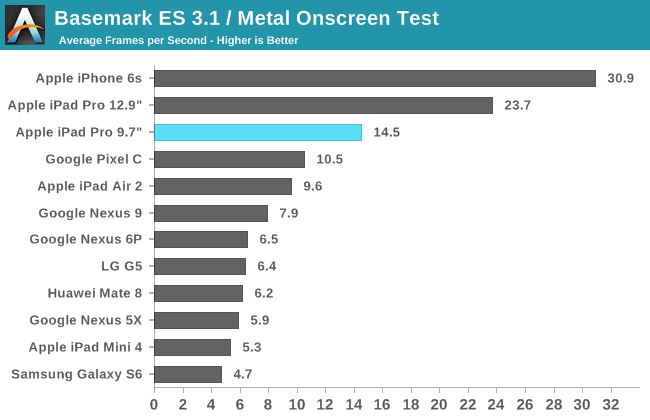
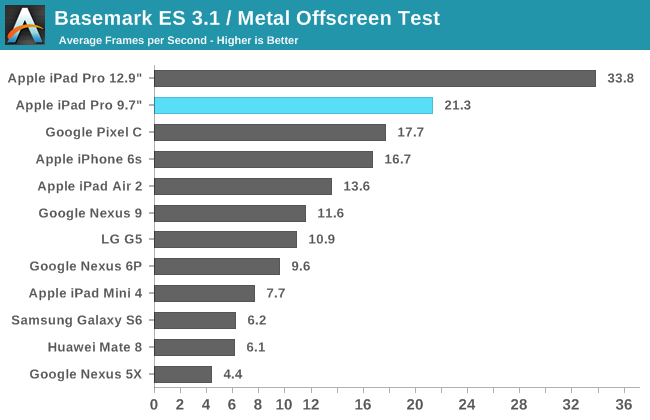
While I didn't have enough data to use BaseMark ES 3.1 at the time of my iPhone SE review, we've since tested enough older devices to deploy it. One could think of this as the successor to BaseMark X, which we retired some time ago before we officially deployed a new mobile test suite for 2016. Once again, both models of the iPad Pro sit above the other tablets on the chart. The iPhone 6s places first in the on screen test due to its relatively low resolution, but without that there the iPads would hold the top two spots in both tests.
NAND Performance
Something that Apple publicized with their A9 and A9X SoCs is improved NAND performance. NAND performance isn't discussed very much in reviews, but it's a very critical aspect of device performance and issues with it tend to cause a device's performance to crash months down the line rather than right off the bat, which makes it something of an invisible problem if you don't look for it during a review. We've seen previously that Apple has been using their own SSD controller in the current generation of iOS devices, and the 9.7" iPad Pro continues this.
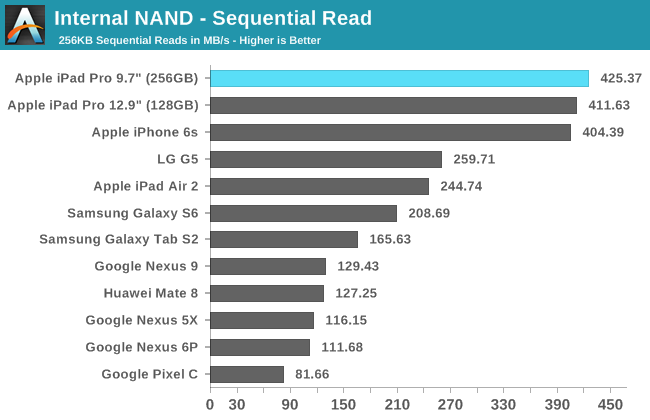
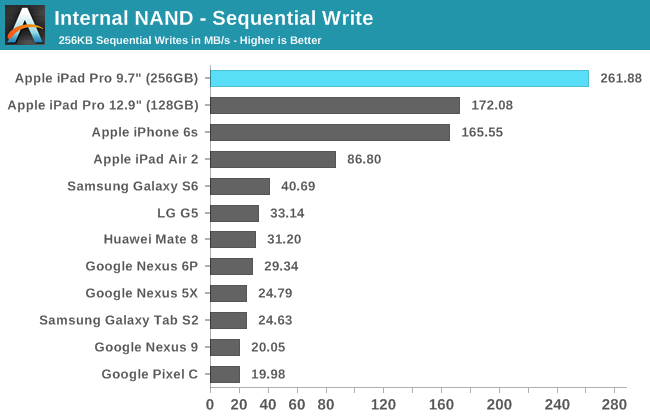
For this review I was sampled the 256GB model of the 9.7" iPad Pro. Because SSDs exploit parallelism heavily to improve performance, a 256GB iPad could improve NAND write performance over the lower-capacity models if it has a greater number of dies. In this case we see that sequential read performance improves a bit, while sequential writes improve dramatically as expected. There's not a lot to say here, as Apple has an enormous lead over the competition in this area.










144 Comments
View All Comments
Klug4Pres - Thursday, June 2, 2016 - link
Didn't stop you in the LG G5 review.Meteor2 - Thursday, June 2, 2016 - link
It would be great if you could source one, I think a lot of people are in this situation. Well, I am :)ragingfighter - Wednesday, July 13, 2016 - link
I still believe the original iPad if you want it is still good enough and it's not necessary to upgrade to even a pro. I would say for a couple reasons one it's in the middle of that list for upgradability so it's still future proof for a few more years, also it has a similar body and weight compared to the others. if it is absolutely necessary you need the best camera well then obviously there will be aspects of the newer tablets upgrade. Drawing also would be the next reason to as well if it's something that you desire or your workflow needs without the use of a laptop or other. All in all though I still consider the first generation iPad Air a recommended keep still. Sure you will get a faster boot up by about 28 seconds give or take and your apps will launch a little quicker but in no way is the original iPad Air or even air 2 sluggish and my opinion. I'm surprise many reviews don't even consider this to their readersKilgharrah - Wednesday, June 1, 2016 - link
Another significant difference not mentioned between the 9.7 and 12.9 is that the larger unit supports USB3 speeds over lightning. The 9.7 is restricted to USB2. This difference is quite noticeable when importing pictures via the new SD card reader or USB adapter.Wolfpup - Wednesday, June 1, 2016 - link
Huh, I didn't know that. That's cool...finally using something akin to an SSD in these things, so the faster speed is actually meaningful (and presumably would be on the three current iPhones and 9.7" iPad too).digiguy - Wednesday, June 1, 2016 - link
I own an air, a mini 2 and a pro 12.9. My air hardly gets any use anymore.. I bought the pro 12.9 as I wanted something larger and lighter than my Surface pro 3 for displaying documents and annotating. And I use it quite often for that, while my SP3 is used mainly a as small portable PC. The main advantage of the big pro for me is precisely its large and beautiful screen. And the 4GB RAM make me feel better when I think I spent close to $1000 for it, as it should last quite a few years. Also something that hardly any review mentions is that the sound of the 12.9 pro is definitely better and louder compared to the smaller pro.jlabelle2 - Thursday, June 2, 2016 - link
"something larger and lighter" : you spend 1000$ on another tablet to gain ... 66g ?Especially considering that one has a kickstand and the other not ?
digiguy - Thursday, June 2, 2016 - link
the exact difference is 85g (just checked both). My main use for reading and annotating is in vertical position. There is no vertical stand on Surface unfortunately. And when you hold it in your hand for some time you can definitely feel the 85g difference. But that's not the only reason. The combination of a inch larger plus a better aspect ratio for vertical position make a difference, making for a true A4 page display. Check here http://i.imgur.com/mmifVfU.jpg (SP3 on the left)And there there are other reasons for the purchase of an ipad pro, but reading and annotating was the main one for me.
trewtrew - Monday, June 6, 2016 - link
I switched from a SP3 to an iPad Pro 12.9" and MacBook Air. I decided that although one device to rule them all sounded awesome, it sucked in practice. It wasn't one of my deciding factors but it's crazy how much more fits on the iPad Pro's screen than the SP3. I figured they both have screens in the 12" range it should be similar but it's not.jlabelle2 - Tuesday, June 14, 2016 - link
A SP3 has a smaller screen than the SP4 and they have a 3:2 ratio which is PERFECTLY the A4 ratio so the it is better in this aspect compared to the iPad Pro but I see that you are showing music partition and there is nothing like iReal Pro or other specialized music softwares on the Surface matching the great selection on the iPad though.